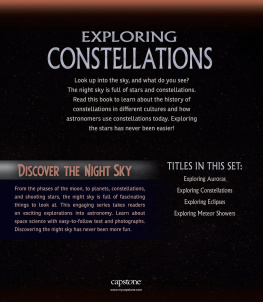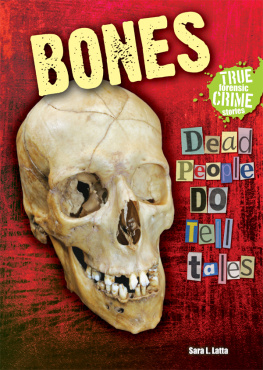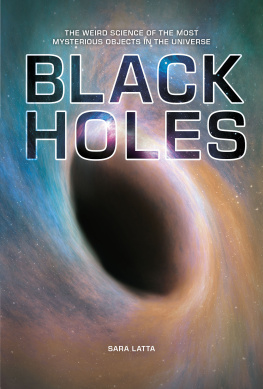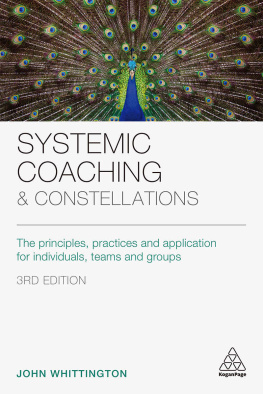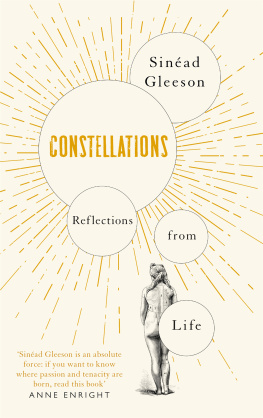Sara L. Latta - Exploring Constellations
Here you can read online Sara L. Latta - Exploring Constellations full text of the book (entire story) in english for free. Download pdf and epub, get meaning, cover and reviews about this ebook. year: 2017, publisher: Capstone, genre: Children. Description of the work, (preface) as well as reviews are available. Best literature library LitArk.com created for fans of good reading and offers a wide selection of genres:
Romance novel
Science fiction
Adventure
Detective
Science
History
Home and family
Prose
Art
Politics
Computer
Non-fiction
Religion
Business
Children
Humor
Choose a favorite category and find really read worthwhile books. Enjoy immersion in the world of imagination, feel the emotions of the characters or learn something new for yourself, make an fascinating discovery.
- Book:Exploring Constellations
- Author:
- Publisher:Capstone
- Genre:
- Year:2017
- Rating:3 / 5
- Favourites:Add to favourites
- Your mark:
- 60
- 1
- 2
- 3
- 4
- 5
Exploring Constellations: summary, description and annotation
We offer to read an annotation, description, summary or preface (depends on what the author of the book "Exploring Constellations" wrote himself). If you haven't found the necessary information about the book — write in the comments, we will try to find it.
Exploring Constellations — read online for free the complete book (whole text) full work
Below is the text of the book, divided by pages. System saving the place of the last page read, allows you to conveniently read the book "Exploring Constellations" online for free, without having to search again every time where you left off. Put a bookmark, and you can go to the page where you finished reading at any time.
Font size:
Interval:
Bookmark:


Look up into the sky on a clear night, far from the lights of a city. You can see the moon, many stars, and maybe even a planet. Some of the stars look like bright diamonds. Others glow faintly. A few of them twinkle. You might look for groups of stars to form patterns. Join the stars in the patterns, like a dot-to-dot puzzle. Do you see a princess? Perhaps you see a dragon.

Thousands of years ago, stargazers around the world did the same. They saw clusters of stars that formed patterns. They thought they looked like animals or people. They told stories about the pictures they saw. These are the constellations.
The Ptolemy named 48 constellations. Today, there are 88 constellations. Together, all of the constellations fill the entire night sky. Each star we can see from Earth is part of some constellation.

The word constellation comes from the Latin word constellatio. It means, set of stars.
Stars are giant balls of hot gas. They make energy. We see that energy as light. Stars come in different sizes and colors. Our sun is a medium-sized yellow star. Stars that are larger than the sun are blue. They are very hot. Stars that are smaller than the sun are red. They are less hot.
Galaxies are made of stars. They are also made of clouds of gas and dust. We live in a galaxy called the Milky Way. If the sky is dark enough, you can see part of it. It looks like a cloudy white streak across the sky. The ancient Romans called it the Road of Milk.


Some stars look close together in the night sky. In reality, they may be very far apart. One of the most familiar constellations is Orion. It is named after a hunter in Greek away from each other. The two brightest stars in Orion are 400 light-years apart! Some look bright because they are closer to Earth. Others look bright because they are very large stars, but the naked eye cant see the difference.

Earth turns on its with each season.
Some constellations appear close to Earths poles. These are constellations. People living in the Southern Hemisphere can see constellations near the South Pole all year. People living in the Northern Hemisphere can see constellations near the North Pole the year round. The lucky ones are the people living near the equator. They can see all of the constellations in the sky throughout the year! The constellations may appear high or low in the sky, depending on the season, but they are always there.
Most constellations are not near the poles. You can only see them during certain times of the year. They are seasonal constellations. You can see some of these constellations in both hemispheres.

Around 5,000 years ago, Middle Eastern astronomers studied the stars and planets. They watched their positions and movements through the night sky as the seasons changed. They used this information to make calendars. These calendars helped farmers know when to plant their seeds. Travelers used the positions of the stars to guide them on their journeys.

Egyptian calendar
These ancient astronomers had another reason for studying the night skies. They believed that the movements of the stars could help them understand the will of their gods. The planets, sun, and moon seemed to pass in front of a different constellation every month. Now we know that it is the other way around. As Earth the sun, we look into space in different directions. That is why we see different constellations throughout the year.
These constellations became known as the .

Although astrology and astronomy have a shared history, they are very different. is the scientific study of everything in outer space. Astrology is the belief that the movements of the stars and planets affect people and events on Earth. It is not a science.
The word Zodiac means circle of little animals.
There are many constellations visible in the Northern Hemisphere year round. Ursa Major, also called Great Bear, is one of them. It is one of the most famous constellations in the Northern Sky. Its seven brightest stars form a feature you may know: the Big Dipper. The Big Dipper is not a constellation. It is an . The two stars on the outer edge of the dipper point directly to the North Star. Sailors used the North Star to find their way at sea. It was always in the north. It can help you figure out which way is north too!
Many cultures told stories about Ursa Major. The ancient Romans said that it was a beautiful woman named Callisto. They said a jealous goddess changed Callisto into a bear.
The tail of Ursa Minor, also called Little Bear, curves toward Ursa Major. The tail looks like a smaller version of the Big Dipper. People sometimes call it the Little Dipper. The North Star is at the very tip of its long tail. Roman legend says that Ursa Minor is Callistos son. He was also turned into a bear.

Cassiopeia is shaped like a W (or an M, depending on the time of year). The constellation appears as a queen sitting on a chair, combing her hair.
Draco represents a dragon that was killed by the Greek warrior Hercules. Dracos body curls like a snake across the sky. It lies between Ursa Minor and Ursa Major.
Crux is the smallest of the 88 constellations. It points the way to the South Pole. It can help you figure out which way is south. The four brightest stars form the Southern Cross. They look like a kite.

Font size:
Interval:
Bookmark:
Similar books «Exploring Constellations»
Look at similar books to Exploring Constellations. We have selected literature similar in name and meaning in the hope of providing readers with more options to find new, interesting, not yet read works.
Discussion, reviews of the book Exploring Constellations and just readers' own opinions. Leave your comments, write what you think about the work, its meaning or the main characters. Specify what exactly you liked and what you didn't like, and why you think so.

